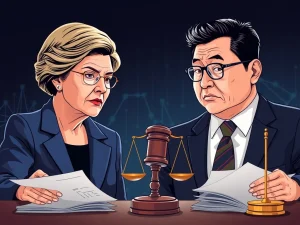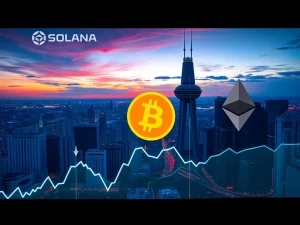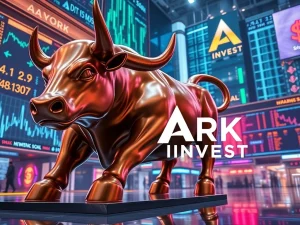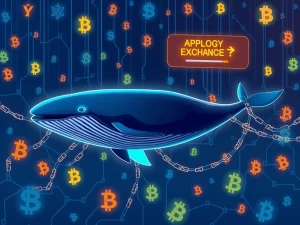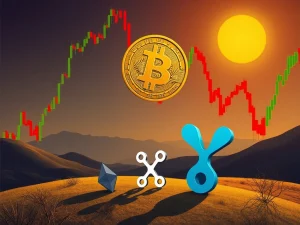Revolutionary XRP Strategy: Evernorth’s Bold Plan to Build a $1 Billion Corporate Treasury
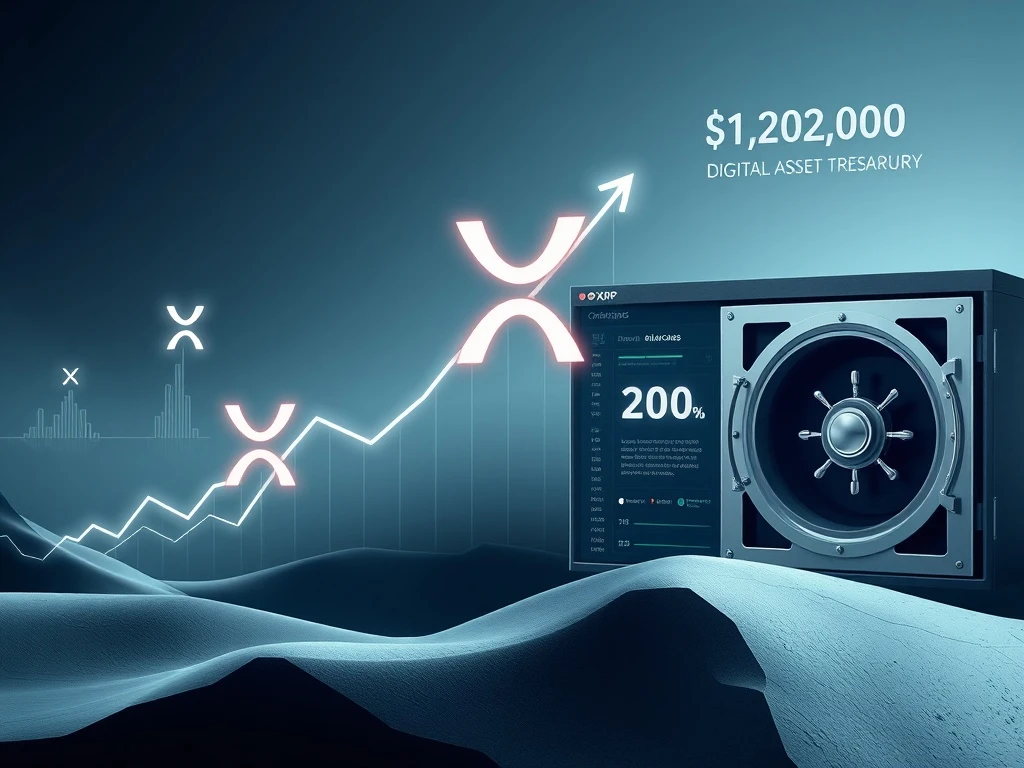
A significant shift is underway in the world of corporate finance and digital assets. Evernorth, a newly formed entity, proposes a groundbreaking approach to integrate XRP into institutional portfolios. This ambitious plan aims to transform XRP into a formidable $1 billion corporate treasury asset. Businesses and investors alike are watching closely as this strategy unfolds, potentially redefining how companies interact with cryptocurrencies. The initiative promises to offer straightforward XRP exposure without the complexities of direct token management.
Evernorth’s Vision: A New Era for Corporate Treasury
Evernorth introduces an innovative concept: a “digital asset treasury.” Its core mission is clear: raise substantial capital, then primarily deploy it to acquire and manage XRP. Rather than compelling companies to hold XRP directly, Evernorth plans to offer a publicly traded stock. This stock will provide XRP exposure through a robust corporate balance sheet, simplifying access for institutions. Consequently, this model addresses many traditional hurdles associated with cryptocurrency adoption.
To accelerate its public market debut, Evernorth is executing a SPAC merger with Armada Acquisition Corp. II. A Special Purpose Acquisition Company (SPAC) serves as a listed shell, enabling private firms to go public more rapidly. Subject to shareholder and regulatory approvals, the combined entity targets a Nasdaq listing in Q1 2026 under the ticker XRPN. The funding objective exceeds $1 billion. Most of this capital will fund open-market XRP purchases. A smaller portion will cover operating and deal expenses. SBI Holdings, an anchor investor, has committed $200 million. Additional backing is anticipated from Ripple, Rippleworks, Pantera Capital, Kraken, and GSR. This capital infusion will help Evernorth build one of the largest XRP treasuries in the public markets.
Evernorth’s leadership is headed by Asheesh Birla, a long-time Ripple executive. He will step down from Ripple’s board to serve as CEO, signaling the company’s independent operation. However, Ripple will continue to offer strategic support. If the deal concludes and funding progresses as planned, Evernorth aims to become the largest publicly traded holder of XRP. This model offers treasurers and investors a direct path to XRP exposure by purchasing stock, eliminating the need for complex wallet, custody, and compliance management.
Did you know? Ripple agreed to acquire prime broker Hidden Road in 2025. This move uses RLUSD as collateral in its brokerage products, marking a broader push into institutional market infrastructure.
Understanding the Evernorth Model: Equity vs. ETF
It is crucial to understand that Evernorth is not launching a spot ETF. Instead, it functions as a public company. This company plans to maintain a significant XRP position directly on its corporate balance sheet. Investors would acquire shares of Evernorth. The company would then utilize the net proceeds to purchase and manage XRP. This structure presents distinct advantages for institutional investors seeking digital asset exposure.
The primary difference from an Exchange-Traded Fund (ETF) lies in active management. An ETF passively tracks its underlying asset. Conversely, Evernorth intends to actively increase “XRP per share” over time. It will achieve this through standard treasury operations. The company also plans to employ tactics such as institutional lending, liquidity provisioning, and selected decentralized finance (DeFi) yield strategies. All these activities will operate within clearly defined and disclosed risk controls. For corporations, this structure offers several benefits:
- Market-hours liquidity: Shares trade during standard market hours.
- Public-company disclosure: Investors benefit from transparent reporting.
- Audited transparency: Financials undergo rigorous auditing.
- Reduced operational burden: Companies avoid building in-house custody and wallet operations.
Since this involves equity, returns may differ from spot XRP performance. These variations can arise from strategic choices, operational expenses, and equity market pricing. The company presents this potential divergence as a source of added value, appealing to those seeking an actively managed approach to digital asset investment.
Why Corporations Choose Evernorth’s Digital Asset Approach
For corporate finance teams, the appeal of Evernorth’s model centers on simplicity and security. Holding a cryptocurrency token directly involves several intricate steps. These include setting up secure wallets, selecting a reputable custodian, drafting comprehensive trading and compliance policies, and training staff. Such internal infrastructure development demands significant resources and expertise. However, Evernorth offers an elegant alternative. Treasurers can instead purchase listed shares designed to mirror XRP exposure. This approach simultaneously provides public-company reporting, external audits, and robust board oversight.
Evernorth also promises active management, not just passive holding. The company plans to regularly publish its XRP holdings. Furthermore, it aims to consistently increase “XRP per share” over time. It intends to achieve this primarily through open-market purchases. Where appropriate, it will also leverage institutional lending, liquidity provisioning, and select DeFi tools to generate additional yield. In essence, Evernorth delivers XRP exposure wrapped in an equity structure. This structure trades during market hours and seamlessly integrates within existing corporate control frameworks. This is particularly valuable for companies desiring exposure to the Ripple/XRP ecosystem without the substantial investment required to build in-house crypto infrastructure.
Did you know? Corporate “crypto treasuries” already exist, primarily concentrated in Bitcoin (BTC). Around 130-160 public companies collectively hold tens of billions of dollars’ worth of BTC, with MicroStrategy leading the trend.
The Mechanics of Evernorth’s XRP Strategy
Evernorth has outlined the operational specifics if the SPAC merger successfully closes. These mechanics cover buying processes, yield generation, custody, and governance, offering transparency to prospective investors and corporate partners.
How the Buying Works
Most of the capital raised is specifically earmarked for open-market XRP purchases. Following the SPAC merger, the combined company expects to list on Nasdaq under the ticker XRPN. Consequently, its balance sheet and treasury policy will adhere to standard reporting cycles mandated by the US Securities and Exchange Commission (SEC). This ensures a high level of regulatory oversight and disclosure.
How Evernorth Aims to Add Yield
Unlike a passive spot ETF, Evernorth proposes an active management approach. The company has indicated plans to participate as a validator on the XRP Ledger. It also intends to use Ripple’s RLUSD stablecoin as a convenient on-ramp for XRP-denominated activities. All these initiatives remain subject to prevailing market conditions and the successful completion of the deal. These strategies aim to enhance the “XRP per share” value for investors.
Who’s in Charge and How it Stays Independent
Asheesh Birla will resign from Ripple’s board to serve as CEO of Evernorth. Ripple will maintain its role as a strategic investor. Meanwhile, Brad Garlinghouse, Stuart Alderoty, and David Schwartz are expected to provide advisory capacities. This organizational structure ensures strong ecosystem alignment. Crucially, it also maintains Evernorth’s daily operational independence, fostering trust and clear governance.
Market Impact: Can $1 Billion in XRP Purchases Move the Needle?
The prospect of over $1 billion in XRP purchases naturally raises questions about market impact. In absolute terms, $1 billion spread over several months represents a meaningful sum. However, it may not be overwhelming for the XRP market. Ripple’s Q1 2025 update reported average daily spot volume for XRP at approximately $3.2 billion across leading venues. This suggests Evernorth would likely pace its purchases carefully to minimize slippage and adverse price movements. Nevertheless, a consistent buyer can tighten spreads and add market depth. Market makers often position themselves for predictable demand, which can benefit overall liquidity. The market structure for digital asset trading has significantly improved in recent years.
Liquidity has indeed improved since earlier periods. In 2025, Kaiko recorded a post-settlement high for XRP on US exchanges. Roughly $116 million in bids and offers were within 1% of the market price. Greater depth generally reduces execution costs. It also helps the market absorb large block flows more effectively. This improvement does not eliminate price risk entirely. Large, clustered orders can still influence the market. However, it makes staged accumulation far more manageable for a large player like Evernorth.
Secondary effects could also emerge. If Evernorth successfully lists, its stock could become an “XRP proxy” for investors unable to buy the token directly. If the market values the stock at a premium, perhaps due to an increase in XRP per share, Evernorth might raise additional capital. This capital could then fund further XRP purchases, creating a reinforcing loop. Conversely, in risk-off market conditions, this positive feedback loop could unwind. Finally, if institutional demand for cryptocurrencies continues to grow through ETF and ETP flows or rising index weights, the market structure around XRP will become even more supportive. Kaiko’s research indicates that indexes beyond BTC and Ether (ETH) have performed strongly. This includes markets where assets like XRP are included, potentially amplifying the impact of a large, methodical buyer such as Evernorth.
Did you know? XRP’s total supply was fixed at 100 billion XRP when the XRP Ledger launched in 2012. The network does not rely on mining, distinguishing it from many other cryptocurrencies.
Key Milestones: What to Watch on Evernorth’s Journey
From regulatory filings to funding specifics and execution signals, the upcoming phase will reveal Evernorth’s preparedness. It will demonstrate its ability to scale its XRP strategy into the public markets. Here’s what stakeholders should monitor as this process unfolds:
-
Regulatory Steps
SPAC deals follow a well-defined regulatory path. Anticipate an SEC Form S-4 filing, which includes the merger proxy and prospectus. This will be followed by an Armada II shareholder vote and standard closing conditions. The companies target a Q1 2026 close. If completed, the combined entity plans to list on Nasdaq under the ticker “XRPN.”
-
Funding Mechanics
Two key factors will influence the final cash balance on Evernorth’s balance sheet. One is Private Investment in Public Equity (PIPE) allocations tied to the merger. The other is SPAC shareholder redemptions. The headline target is over $1 billion in gross proceeds. This includes $200 million from SBI, with additional participation expected from Ripple, Pantera, Kraken, and GSR. The final funding mix at closing will directly affect Evernorth’s initial capacity to purchase XRP.
-
Playbook Disclosure
Watch for a formal treasury policy outlining several crucial details. These include the frequency of purchases, any blackout windows, and hedging rules. Expect specific details on named custody providers and key performance indicators like “XRP per share.” The company has also mentioned potential validator participation and the use of Ripple’s RLUSD stablecoin as an on-ramp into XRP-based DeFi. Filings should clarify these planned activities.
-
People and Governance
Asheesh Birla will step down from Ripple’s board to serve as Evernorth’s CEO. Ripple executives are expected to act as advisers, reflecting alignment with the broader ecosystem. This structure aims to maintain operational independence for Evernorth. Look for the final board slate and committee structure, including audit and risk, in the Form S-4 filing.
-
Execution Signals
After listing, the early indicators will be critical. These include PIPE close details, the first disclosed XRP purchases, and the rhythm of quarterly reports. Together, these indicators will reveal whether Evernorth is successfully scaling into the large public XRP treasury it has outlined.
Evernorth’s ambitious plan represents a significant development for the digital asset space. It offers a novel pathway for institutional investors to gain exposure to XRP. This strategy could set a precedent for future corporate engagements with cryptocurrencies. Its success hinges on robust execution, clear regulatory navigation, and consistent market demand.

